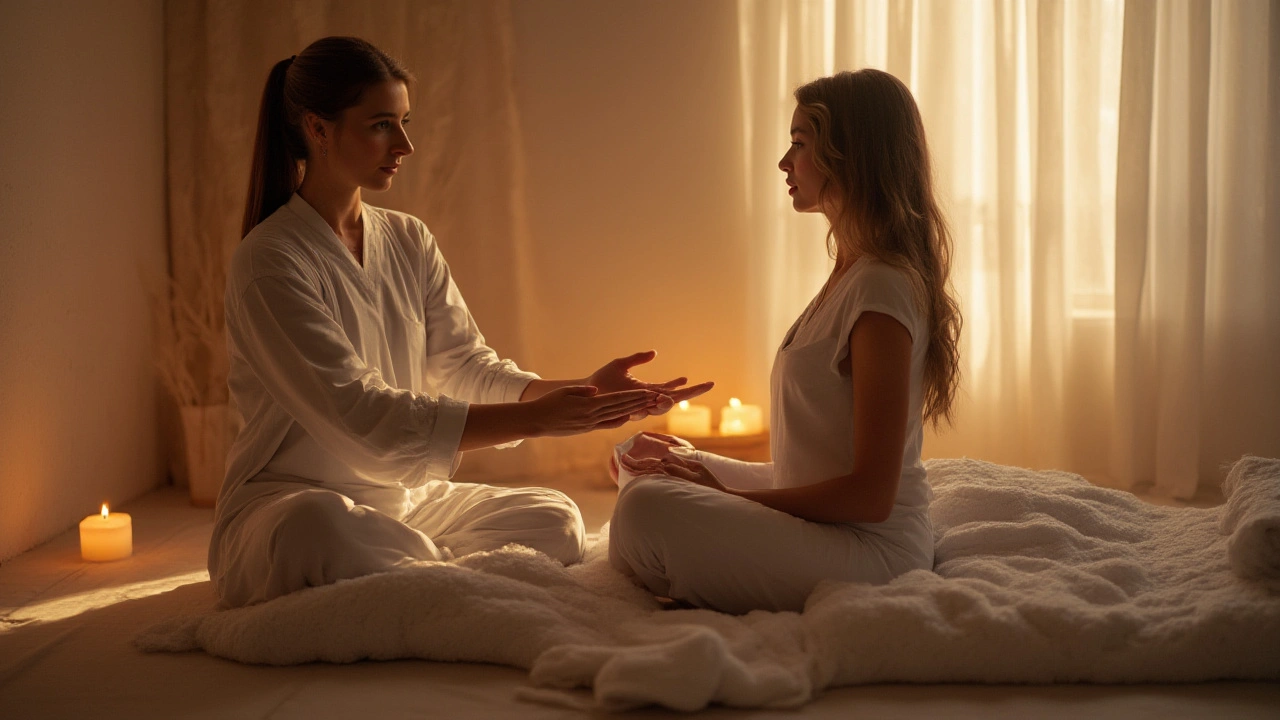Blind Massage Therapy: The Rising Trend Revolutionizing Holistic Healing
 Jul, 6 2025
Jul, 6 2025
Ever notice how trends in wellness pop up out of nowhere and suddenly everyone has an opinion? Blind massage is one of those trends, but beneath the surface, it’s way more than hype. This isn’t just about feeling good physically; there’s a whole layer of inspiration, skill, and hard science at play. People are traveling across cities just to book a blind massage because it comes with some serious benefits, including precise muscle relief and a mental calm you didn’t know you needed. If you’ve ever wondered why this approach is grabbing the wellness world’s attention, or thought about trying it yourself, you’ll want to stick around for the real story behind blind massage therapy.
Blind Massage: Where Perception Becomes Power
The idea behind blind massage is blunt—take a therapist who cannot see, and let their hands do all the talking. At first glance, some skeptics wondered if this was a novelty. But if you look at the real experiences of people who step out of these sessions, you’ll find something different: blind massage therapists often develop a heightened sense of touch that’s nearly impossible for most sighted therapists to match. There’s hard proof, too—a study published in the "Journal of Bodywork and Movement Therapies" found that blind therapists consistently identified muscular tension faster and with greater accuracy than their sighted colleagues.
In China, blind massage has actually been around since the 13th century, rooted in both traditional Chinese medicine and a history of relying on the extraordinary sensory skills of the blind. This tradition is now booming in places like Singapore, Austria, and even cities across the United States. What’s behind the popularity? When sight is taken out of the equation, it turns out, every other sense gets supercharged. Blind practitioners often say they can “see” with their fingers, detecting subtle changes in muscle fibers, skin temperature, and even energy flow. Some clients report that a single blind massage session unraveled chronic tension that had been stubborn for years, even after seeing countless other therapists.
Despite being a growing trend, getting certified as a blind massage therapist is no shortcut. In many countries, there are strict government-backed licensing processes with special adaptations for visually impaired students. Blind massage courses in Beijing, for example, can take up to two years and involve hundreds of hours of supervised practice. The focus—nothing less than perfection in movement, sensation, and safety.
People are now lining up in wellness centers and hotels, looking specifically for blind therapists, because they want that deep, targeted experience. Word of mouth travels fast, especially when you get results that go way beyond a traditional spa massage. If you get a chance to try a blind massage, expect a different atmosphere—the therapist will probably listen carefully to your history, ask you about pain points, and unlock knots that nobody else even noticed before.
The Science Behind Sensory Superpowers
Wonder what actually sets blind massage apart from other forms of therapeutic bodywork? It starts with the brain. When a person loses one sense, their brain adapts by rewiring to heighten others, and the hands become the main medium of communication for blind therapists. This is more than just a myth; there’s serious research behind it. A 2017 MRI study from the University of Montreal found that the somatosensory cortex—the part of the brain tied to touch—actually grows denser and more active in blind people. This boost in touch perception translates directly to better pain relief and muscle reading for clients.
The training methods are unique, too. Blind massage schools use tactile models and real-life practice to teach anatomy, using raised diagrams and hands-on mentorship. Therapists must memorize not just muscle groups, but the way tension “feels” under their fingers. Some schools run workshops in complete darkness to train both blind and sighted therapists to rely only on tactile cues.
| Therapist Type | Average Training Hours | Reported Client Satisfaction (%) | Accuracy in Tension Detection |
|---|---|---|---|
| Blind Massage Therapist | 1000+ | 94 | High (80-90%) |
| Sighted Massage Therapist | 600-900 | 85 | Moderate (65-75%) |
It’s not only the touch that sets blind massage apart. Blind therapists often develop a powerful listening style—both through interviews and in real-time feedback throughout a session—which helps tailor each treatment. If you’ve ever laid silently on a massage table and thought, “I wish they’d hit just the right spot,” blind massage might be your perfect fit. Clients with chronic conditions like fibromyalgia, sciatica, or recurring sports injuries report significant improvements—not just due to hands, but thanks to a unique, person-centered approach that almost feels custom-built.
So, if you’re seeking lasting relief, don’t just look for strong hands. Look for a therapist who treats the experience as a dialogue, tuning in with every muscle twitch and breath. That’s where blind massage goes miles beyond the rest.

Why Blind Massage Works: Real-World Benefits and Surprising Stories
Here’s where things get interesting. There’s a long-standing belief that human touch heals, and blind massage takes this idea right to the core. For a lot of clients, it’s not just about physical pain—it’s also about anxiety, insomnia, or emotional exhaustion. Blind therapists often leave clients feeling “seen” (ironically), shifting both mind and body into a calmer state. And the results aren’t just anecdotes. A large-scale study out of Nanjing Medical University in 2022 tracked over 1200 regular clients of blind massage clinics. It found a drop of 25% in reported chronic pain levels over six months, while nearly 70% noticed a big jump in mood and sleep quality.
People struggling with postural tension from long hours at work, or athletes pushing their limits week after week, say blind massage offers focused relief where other therapies fall short. The therapist’s ability to pinpoint issues—sometimes without even asking where it hurts—can feel nothing short of magical. Several pro tennis players in Asia, including Li Na, have publicly credited blind massage with speeding up injury recovery between tournaments.
If you’ve ever been wary about discussing personal discomforts with a therapist, blind massage adds another layer of comfort. Stripped of visual cues, sessions often feel less intimidating and more honest. Some clients describe it as “liberating”—finally able to express tension or pain without embarrassment, knowing the therapist is completely focused on the tactile experience.
Blind massage can also be deeply rewarding for the practitioners themselves. In many countries, people with visual impairments face serious barriers to employment. Massage therapy offers a respected, financially stable career path. The World Health Organization estimated in 2023 that in China alone, thousands of blind people found meaningful work through licensed massage centers. This social impact is part of why the blind massage trend isn’t just a fad. When you lie down for a session, you aren’t just paying for expert touch—you’re helping break cycles of unemployment and stigma for visually impaired folks around the world.
- Blind massage can reveal “hidden” issues that might not show up in a standard physical exam.
- Schedule sessions regularly (try once every 2-3 weeks for ongoing relief).
- If you’re new to massage, tell your therapist about old injuries up front—they’ll use this info to fine-tune their approach.
- Don’t stress about awkward silences—blind therapists often read your body language through subtle signals you’re not even aware of.
- Many centers let you choose between different types: acupressure, Shiatsu, deep tissue, and more. Ask what’s best for your needs.
Now, blind massage isn't a miracle cure for every problem, but when paired with the right lifestyle tweaks, it can play a big role in whole-body wellness. It’s also more affordable than many alternative therapies, especially in countries where it’s state-supported.
How to Find the Right Blind Massage Experience
If you’re thinking of booking your first session, finding a reputable, skilled blind massage therapist is key. The easiest way? Look for clinics or spas with a clear certification process for their staff. Many countries, like China, Japan, and Indonesia, have regulatory bodies that supervise and certify blind massage practitioners. In the U.S., organizations like the National Certification Board for Therapeutic Massage & Bodywork sometimes offer specialized programs for visually impaired students.
Word-of-mouth is gold in this world, too. If you have friends who rave about their blind massage sessions, start there. If you’re traveling to big cities in Asia, keep an eye out for blind massage therapy centers, as these tend to attract the most skilled practitioners. Try to avoid “walk-in” spots that don’t show training credentials; quality and safety matter just as much as touch.
For safety and hygiene, check whether clinics use disposable covers and clean equipment between clients. Many modern facilities also keep records of medical history to personalize treatments even further.
Not sure what type to book? Here are a few options most centers offer:
- Acupressure massage – Uses targeted pressure on specific points to relieve muscle tension and boost energy flow. Great for headaches, neck and shoulder pain.
- Deep tissue massage – Focuses on the deepest muscle layers; helps with chronic knots and injury recovery.
- Reflexology – Targets “zones” on the feet, hands, or ears. Useful if you want systemic benefits without full-body contact.
- Relaxation massage – Uses long, gentle strokes for stress relief and better sleep.
If you’re nervous before your first session, that's totally normal. Share your preferences or concerns openly. Blind therapists have a knack for reading not just muscles but moods, and they’ll do their best to make you comfortable from the moment you arrive.
To get the most out of your experience, avoid heavy meals or caffeine right before your massage. Wear loose clothing, show up a few minutes early to relax, and don’t forget to hydrate after. A good blind massage can release a wave of endorphins and flush out toxins—water helps speed up the recovery process.
So next time you need serious healing—body or mind—consider the hands that don’t rely on sight. Blind massage isn’t just a trend; it’s a whole new way of tuning into yourself, guided by someone who’s tuned every sense to perfection.
